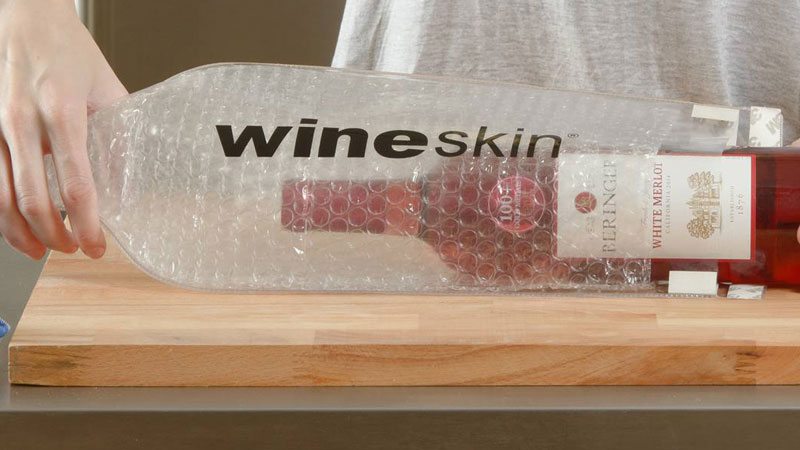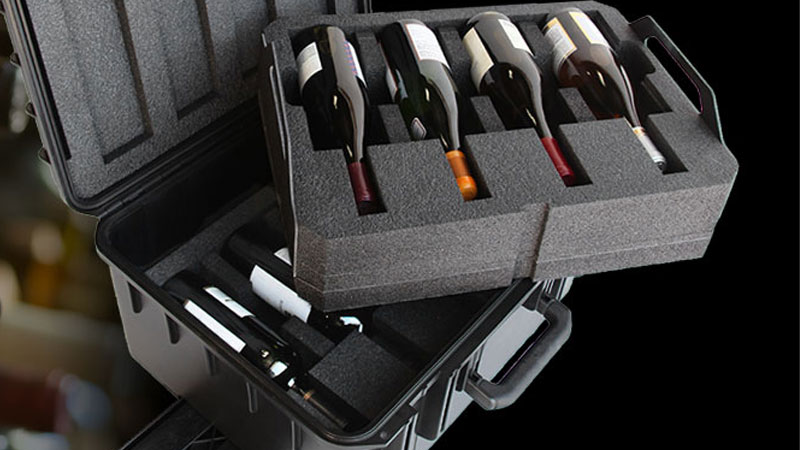What’s the best way to travel with wine bottles? “Carefully!” laughs Bradley H. Groper, vice president sales, Long Meadow Ranch Wine Estates.
Groper is on a plane 50 or more times a year and estimates he’s lugged some 20,000 bottles around the globe in his 35 years of traveling with wine. His greatest fear is a bottle or two of a case disappearing into the black hole of airline luggage. It’s never happened, he says, though once a case did go missing for two weeks.
Salespeople and air travel authorities assure Groper and the rest of us that corkscrews, not theft, are the biggest wine-related victims of airport security checks. So let’s thank the Transportation Security Administration (TSA) for keeping us and our bottles safe.
The TSA was created — transferred from the Department of Transportation to the Department of Homeland Security — in 2001 in response to Sept. 11. The TSA’s ban on liquids over 3.4 ounces in carry-ons launched in response to a transatlantic threat in August 2006.
Shortly after, Aaron Snyder, a Beverly Hills-based attorney and wine enthusiast, was on a trip with a transfer in London. His experience inspired him to create the WineSkin, a bubble wrap jacket designed for wine bottles. Until then, like most everyone else, Snyder says he was using “the usual: socks, underwear, shirts, bubble wrap, travel boxes provided by wineries, as bulky as they were.”
Today his WineSkins are used by wineries, big-box retailers, promoters, and sales people like Groper. WineSkins offers options ranging from single use to reusable to inflatable to hyper-absorbent to recyclable. There are other types of sleeves designed to safely shepherd wine from terminal to terminal, too, including the JetBag, MonTien, VinoLock, WineHero, and WineWings.
VinePair spoke with frequent-traveling wine professionals to determine the best travel escort for your bottles. The quantity of bottles plays a greater role than one might think, as does luggage type, itinerary (connections? delays?), and bottle shape and weight. Rest assured, getting your wine safely from point A to B is absolutely possible with analysis and advance planning.

Irene Lozach, sales manager at Healdsburg, Calif.-based PJK Wineries, has been traveling with wine for 25 years. Recently, she purchased a bunch of wine sleeves and put them to the test.
She used the JetBag on a flight from New York to Atlanta. “It’s like wrapping the bottle in a diaper,” Lozach says. “It works but only [slightly] better than a thick sock in case the bottle actually broke, because it would absorb.”
Lozach packed several bottles in her suitcase using Wine Wings on a flight from NYC’s Laguardia Airport to Chicago’s O’Hare. “One broke, though the wine was completely contained in the sac with zero leakage,” she says. Despite the broken bottle, she characterized the experience as “pretty impressive.”
Her favorite purchase, however, was the Montinen Wine Bottle Protector, which she used to transport a small number of bottles from New York to Minneapolis-St. Paul. Lozach praised its thick bubbles, supple plastic, and easy cleanup and storage. “The winner!”
Michael Quinttus, CEO of Vintus, importer of fine wines, is on an airplane 25 times a year. He travels with no fewer than three bottles at a time. His greatest fear is neither breakage nor confiscation: It’s delays.
Wine is often the only reason he has checked baggage. “With correct packaging, breakage isn’t an issue,” Quinttus says. “We all have stories about people who did have broken bottles, but it’s typically when they tried to pack some bottles within their personal items.”
Quinttus safeguards his cargo by customizing the sleeves and suitcases by the number of bottles he is transporting. When he flies with one to three bottles, he uses a cardboard shipper with pulp inserts, like the 3-Pack by Landsberg. “Just add tape,” he says.
When traveling via air with four to six bottles, “you have to go with a WineCruzer,” says Quinttus. It’s a foam-lined, airtight, hard (polypropylene copolymer resin) case that comes in 10 shapes and sizes, with and without wheels.
Weight can be another issue with airport luggage. Each airline has its own weight restrictions. Stay within the limit or prepare for fees, which will likely be cheaper than shipping costs. Additionally, the TSA, other agencies, and every country have regulations governing the transport and shipping of alcohol — ABV, quantity, taxes. Be sure to check before traveling and/or shipping.
Groper speaks for everyone in the industry when he suggests planning ahead when flying with 12 wine bottles (a.k.a. one case) or more. Last month, he checked 24 bottles in “shippers,” professional wine shipper boxes, for a trip to Hong Kong. That was a chore. “Have it sent!” exclaims Quinttus without hesitation.
“Industry and folks in the know check a case or more with airlines inside professional wine shipper boxes,” agrees Shawnda Hansen, a former Napa and Sonoma wine tour guide “The caveat is that it’s difficult to manage a 40- to 50-pound box without wheels or handles.”
About 10 years ago, when Hansen was leading wine tours, she realized the primary reason people weren’t purchasing wines they’d tasted and loved was the difficulty and expense of getting bottles home.
“There was, and still is novelty, expensive luggage dedicated for wine,” she says, “but many who travel with wine would prefer to spend that money on wine, and not expensive luggage.” The latter, she says, might collapse, or “can easily throw a case of wine over the 50-pound domestic weight limit, imposing more cost.”
So she partnered with Todd French to create the Wine Check. Launched in 2010, the Wine Check is a foldable, padded case that holds up to 12 bottles of wine. Customers, primarily tourists, send her pictures of the product in airports all over the world, Hansen says.
Another consideration is the size and shape of the bottles themselves, which can vary by region. If the bottles you need to transport are outside the usual shapes and sizes — too tall, too bulbous, too gigantic — you may be left to your own devices. That’s why Sophia Zaïme, founder of Madame Wine, a Paris-based service that matches wine lovers with wine, alters packaging accordingly. Bubble wrap is her go-to.
Groper agrees and also suggests shippers designed to fit magnums, Champagne bottles, and so forth.
If not flying, Groper, his team, and countless others in the industry recommend a Chill’nGo. “It’s the leader in this field and has been for decades,” he says. According to the company website, the Six Bottle Salesperson’s Bag is the most popular.
Your priorities will ultimately steer your packing decisions. Zaïme, for example, says that boxes beat bags every day. “It’s safer,” she says. Breakage in a suitcase is her greatest fear.
“I don’t care about my clothes but I do care about the wine,” she says. We couldn’t find a wine lover anywhere who disagrees.

Best Way to Fly With 1-2 Bottles
For a haul of this size, package your bottles in sleeves and fit them into your luggage — just be sure to check airline regulations in advance. Long Meadow Ranch’s Bradley H. Groper likes WineSkins; PJK sales manager Irene Lozach tested several sleeves and says Montien is her favorite.
Best Way to Fly With 3 Bottles
Vintus CEO Michael Quinttus likes to use cardboard shippers with pulp inserts, such as this 3-Pack by Landsberg.
Best Way to Fly With 4-6 Bottles
WineCruzers are airtight and foam-lined and come in 10 shapes and sizes, with and without wheels. (Quinttus is partial to ones with wheels.)
Best Way to Fly With 12+ Bottles
Check professional wine shipper boxes as you would luggage with your airline. Shawnda Hansen, a former Napa tour guide, partnered with Todd French to create The Wine Check, a foldable case that holds up to 12 bottles of wine.
Best Way to Fly With Bottles of Unusual Shapes
Bubble wrap is the go-to for Madame Wine founder Sophia Zaïme. Groper also suggests planning ahead and packing shippers designed to fit magnums or Champagne bottles.
Best Way to Carry Wine if Not Flying
Chill’nGo offers temperature-controlled totes with ergonomic shoulder pads (the six-bottle Salesperson’s Bag is the most popular, according to the website) that Groper calls “the leader in this field.”
